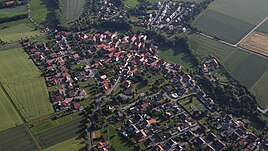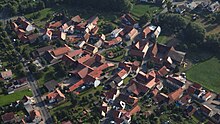Tiftlingerode
|
Tiftlingerode
City of Duderstadt
|
||
|---|---|---|
| Coordinates: 51 ° 30 ′ 5 ″ N , 10 ° 14 ′ 35 ″ E | ||
| Height : | 190 m | |
| Residents : | 902 (Nov. 1, 2019) | |
| Incorporation : | 1st January 1973 | |
| Postal code : | 37115 | |
| Area code : | 05527 | |
|
Location of Tiftlingerode in Lower Saxony |
||
|
Aerial view
|
||
Tiftlingerode is a place in the district of Göttingen in Lower Saxony and is located on the district road 112 between Immingerode and Duderstadt and Gerblingerode , a good one kilometer southwest of Duderstadt in the Goldenen Mark . The village, which belongs to the Untereichsfeld , has been part of the city of Duderstadt since January 1, 1973 and has around 900 inhabitants.
history
Tiftlingerode was first mentioned in a document on November 8th, 1141. At that time, Count Siegfried IV von Boyneburg granted the Benedictine monastery Northeim various rights and also confirmed the listed property. A farm in "Theodolwingerothe" is mentioned in the series of possessions. The intention that was pursued was obviously to protect Northeim Monastery from claims by the Archbishop of Mainz and from attacks by the Count von Dassel . Another mention of the village can be found in a certificate from Heinrich the Lion , which was issued on November 24, 1162 in Herzberg and is considered to be false. In this document, Heinrich confirms the possession of the place "Theodoluingerodh" (also listed as "Theodoluesgerod") to the Northeim Monastery . The fact that Tiftlingerode already existed around 990 under the name "Thiedilfingigirod" cannot be precisely determined, as a document from the same year in which Otto III. the Marienkloster in Gandersheim confirmed possessions, counts as a forgery. An old manuscript provides information that from the 13th century the Lords of Billingshausen in the villages of Herwigshagen (Herbigshagen), Gerblingerode and Tiftlingerode owned the tithe as a fief before the Lords of Westernhagen bought that tithe from them in the 14th century . Archaeological finds lead to the conclusion that a church building, probably in the form of an Ottonian fortified church , already stood on the former church square in the 10th or 11th century . The trigger for the assumption of an earlier Ottonian fortified church came in 1986. At that time, as part of the redesign of the former church hill in the old village center, an area excavation was carried out with the aim of documenting older church remains. The remains of its predecessor Ottonian building were found under and next to the foundation of the Church of St. Nicholas, which was demolished in 1983. Reconstructions allow the conclusion that it was a single-nave hall church building with a retracted square choir and a total length of around 20 m. The church was the center of a ring-shaped fortification and was in manorial catchment area of the neighboring liudolfingischen Villikationshaupthofes Duderstadt.
From 1432 to 1815, Tiftlingerode was one of eleven council villages that were politically and judicially dependent on the city council of Duderstadt . He was obliged to deliver goods in kind and services. During the wars of the 17th and 18th centuries, the place was affected by looting, billeting and high contributions. In 1934 the local volunteer fire brigade was founded in Tiftlingerode . The promotion of the volunteer fire brigades in Eichsfeld took place mainly after the National Socialists came to power in 1933, the creation of the Eichsfeld fire brigade was based primarily on those two reasons that allowed them to be integrated well into the leadership principle on the one hand due to their hierarchical structure and on the other in this way the military economic potential for the upcoming war should be preserved.
Place name
The change from Theodolwingerothe to Tiftlingerode may not be linguistically correct, but such a leap in name is not entirely unusual. Professor Dr. Ulrich Scheuermann from the Institute for Historical Research at the University of Göttingen , who, as the editor of the Lower Saxon dictionary, is probably the leading expert in the field of Lower Saxony name research, also comes to the unequivocal judgment that “Theodolwingerothe” is the older form of the name for Tiftlingerode . It is also possible that the name can be interpreted as the "clearing settlement of the Therdolf people".
Population development
- 1813: 144
- 1848: 214
- 1863: 218
- 1925: 288
- 1933: 313
- 1939: 392
- 1961: 595
- 1970: 768
- 2008: 938
politics
Local council
The local council consists of nine councilors and councilors.
(As of: local election on September 11, 2011 )
coat of arms
The coat of arms was approved on April 11, 1951 by the Lower Saxony Ministry of the Interior.
Blazon : “In blue a growing bishop figure, who holds a closed blue book with a silver section with three red apples in his right hand, and in his left hand a golden bishop's staff curved inwards. Upper garment and miter in gold, face and hands in silver. "
The coat of arms shows St. Nicholas, the church patron of the community of Tiftlingerode.
The graphic artist and painter Fritz Reimann from Fuhrbach designed the town's coat of arms.
Attractions
St. Nicholas Church
Today's Catholic Church of St. Nicholas is the third church building in Tiftlingerode. Predecessor churches were houses of worship from 10/11. Century as well as a baroque church built in 1687 on the initiative of the archbishop commissioner Herwig Böning . This was expanded with additions to the nave in 1867 and used until 1983. The construction of a new parish church began as early as 1978, and the location of the previous buildings was no longer chosen as the starting point. The new building was on September 20 in 1980 by Heinrich Maria Janssen , the then Bishop of Hildesheim, consecrated . Today's church shows itself as a yellow brick , single-storey building with a slate-covered tent roof and extensions for rooms that are used by the community. A separately standing bell tower with a total height of 21 m is formed by four free-standing concrete pillars with yellow brickwork on the outside. A deep-drawn slate helmet acts as the roof . In the interior of the church, the wood-paneled sloping roofs of the self-supporting roof structure extend over the chancel , which is highlighted by a few steps. Similar to other churches in the lower area , the altar was fitted into a wide angle of the spatial polygon. The background of the chancel is formed by a shell limestone wall, which bears an old Gothic cross from the immediately preceding church. A radiant wreath Madonna and a figure of Santa Claus have also been preserved . There are also relief motifs on the wall , which are repeatedly shown on the altar, ambo and tabernacle . The side walls are divided by four rectangular windows on which images from the legend of Mary, Martin and Nicholas are shown. The colors of the windows, in red, orange, blue and shades of gray, refer to the symbolism “day and night” as well as “sun and moon”. Since November 1, 2014, the church has belonged to the parish of St. Cyriakus , based in Duderstadt.
Village square
From the listed church built in 1687, the substructure of the choir room is still preserved at the old location. This remains of the building was given a new roof and closed with a grille, inside there is a stone altar table, a baptismal font, a crucifix and two sandstone plaques to commemorate those who fell in the world wars. The former location of the church was transformed into a village square in 1986, and trees were planted at the location of the nave side walls. In the west of the square, a bronze plaque placed next to the old bell reminds of the history of the church.
societies
- Tiftlingerode volunteer fire brigade
- Youth wind orchestra Tiftlingerode
- Tiftlingerode tennis club
- VfB Tiftlingerode from 1920.
- TT Tiftlingerode
- Hiking group Tiftlingerode 1980.
- Choral society unity
- Kolping family Tiftlingerode
swell
- www.tiftlingerode.de
- Michael Rademacher: German administrative history from the unification of the empire in 1871 to the reunification in 1990. duderstadt.html. (Online material for the dissertation, Osnabrück 2006).
- www.duderstadt.de
Web links
- Site of the place
- Hamburger Abendblatt: Lower Saxony's most child-friendly village
- Hamburger Abendblatt: The uniform losers from Tiftlingerode
- Zeit Online: Caught in the savings trap
- Spiegel Online: No future for the cow guild
- Spiegel Online: How a congregation woos young families
- Bild.de: Tiftlingerode A small village is the children's paradise
Individual evidence
- ↑ The villages of our city. Population statistics (as of November 1, 2019) , accessed on May 7, 2020.
- ↑ a b c Federal Statistical Office (ed.): Historical municipality directory for the Federal Republic of Germany. Name, border and key number changes in municipalities, counties and administrative districts from May 27, 1970 to December 31, 1982 . W. Kohlhammer, Stuttgart / Mainz 1983, ISBN 3-17-003263-1 , p. 206 .
- ↑ Karl Jordan (edit.), The documents of Heinrich the Lion - Duke of Saxony and Bavaria. Anton Heisemann, Stuttgart, 1957–1960, p. 85.
- ^ Theodor Sickel (arrangement): The documents of Otto III. Hahnsche Buchhandlung, Hanover 1997, p. 862.
- ^ Johann Wolf: Eichsfeldisches Urkundenbuch together with a treatise on the Eichsfeldischen nobility . JC Baier, Göttingen 1819, p. 10 .
- ↑ Andreas Degenhardt u. a .: The historical development of the Eichsfeld fire department. In: Eichsfeld yearbook. 2007, p. 141.
- ^ Johann Georg Heinrich Hassel: Statistical Repertory on the Kingdom of Westphalia . Vieweg, Braunschweig 1813, p. 108 .
- ↑ Friedrich Wilhelm Harseim, C. Schlüter: Statistical Manual for the Kingdom of Hanover . Ed .: Friedrich Wilhelm Harseim, C. Schlüter. Schlütersche Hofbuchdruckerei, Hanover 1848, p. 81 .
- ↑ H. Rudolph: Most complete geographic-topographical-statistical local lexicon of Germany, namely of the entire German federal states, as well as the non-German states that are subject to Austria and Prussia . tape 2 . Ferber & Seidel, Leipzig 1863, p. 4594 .
- ↑ wahlen.kds.de
- ↑ History of the old church and the church square in Tiftlingerode , information board at the old church square in Tiftlingerode
- ↑ Peter Ferdinand Lufen: Göttingen district, part 2. Altkreis Duderstadt with the communities Friedland and Gleichen and the joint communities Gieboldehausen and Radolfshausen . In: Christiane Segers-Glocke (Hrsg.): Monument topography Federal Republic of Germany. Architectural monuments in Lower Saxony . tape 5.3 . CW Niemeyer, Hameln 1997, ISBN 3-8271-8257-3 , p. 203 f .






